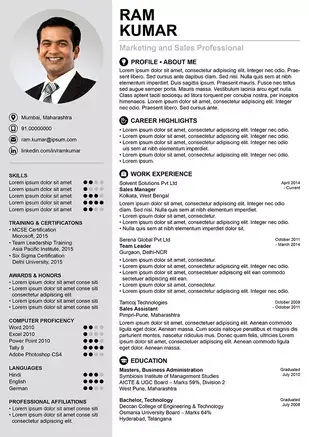- International Marketing and Sales , Completed , January 2006
- Transform Your Business Analyst Career , Completed , January 2008
What's your job?
Business Analyst Resume Samples and Templates for 2026
- Table of Contents
- Downloadable Sample
- Resume Tips from Experts
- Resume Text Version
- Share
Business Analyst Resume Guide for India
A well-crafted business analyst resume is essential for success in India’s thriving IT and consulting job market. Whether you’re a fresher starting your BA career or an experienced professional seeking positions at top companies like TCS, Infosys, Accenture, or leading product companies, this guide provides everything you need to create a standout resume that impresses Indian employers and passes ATS screening on portals like Naukri and LinkedIn.
This comprehensive guide includes:
- Resume format recommendations for Indian IT and consulting sectors
- Key skills Indian employers look for
- Complete resume example with Indian context
- Top business analyst employers in India
- Salary insights in INR by experience level
- Certification guidance for the Indian market
- ATS optimization tips for Indian job portals
Why Your Business Analyst Resume Matters in India
India’s IT services and consulting sector is among the largest globally, with companies like TCS, Infosys, Wipro, Accenture, Cognizant, and Capgemini actively hiring business analysts. A strong resume helps you:
- Stand out from thousands of BA applicants on Naukri and LinkedIn
- Pass ATS screening used by major IT companies and consulting firms
- Showcase skills that Indian hiring managers value, including requirements gathering, Agile, and SQL proficiency
- Demonstrate your domain expertise and project experience
Indian hiring managers typically spend 6-10 seconds reviewing each resume initially. Your business analyst resume must immediately communicate your analytical skills, domain knowledge, and value proposition. With India being a global hub for IT services and digital transformation, BA opportunities are excellent—a well-optimized resume is your gateway to top companies.
Business Analyst Resume Format for India
Indian employers prefer clean, professional resume formats. Here’s what works best for BA positions:
Recommended Format
- Length: 1-2 pages (freshers: 1 page, experienced: 2 pages max)
- Layout: Reverse chronological (most recent first)
- Font: Arial, Calibri, or Times New Roman (11-12pt)
- Sections: Contact, Summary, Skills, Experience, Projects, Education, Certifications
Resume vs Biodata
In India, “biodata” is rarely used for BA roles. Use a professional resume format for IT, consulting, and corporate BA positions.
Personal Details for Indian BA Resumes
Indian resumes typically include:
- Full name (professional photo optional)
- Phone number with country code (+91)
- Professional email address
- LinkedIn profile URL
- City, State (full address not required)
What to Avoid
- Decorative fonts or graphics (causes ATS issues)
- Personal information like religion, caste, or father’s name
- Salary expectations (discuss during interview)
- References (provide when requested)
Key Skills for Business Analysts in India
Indian employers look for a combination of analytical, technical, and soft skills.
Business Analysis Skills
- Requirements Gathering: Elicitation techniques, stakeholder interviews, workshops
- Documentation: BRD, FRD, SRS, user stories, use cases
- Process Modeling: BPMN, flowcharts, swimlane diagrams
- Gap Analysis: As-is vs to-be analysis, impact assessment
- UAT Coordination: Test case review, defect management
- Agile/Scrum: Sprint planning, backlog grooming, retrospectives
- Waterfall: Traditional SDLC methodology
Technical Skills
- SQL: Query writing, database analysis, data validation
- Excel: Advanced functions, pivot tables, VLOOKUP, data analysis
- Data Visualization: Power BI, Tableau, QlikView
- Tools: JIRA, Confluence, Azure DevOps, ServiceNow
- Prototyping: Wireframes, mockups (Figma, Balsamiq)
- ERP Knowledge: SAP, Oracle, Salesforce basics
Domain Knowledge (Valued in India)
- BFSI: Banking, financial services, insurance processes
- Healthcare: Claims processing, provider management
- Retail/E-commerce: Order management, inventory systems
- Telecom: Billing, CRM, network operations
- Manufacturing: Supply chain, ERP, production planning
Soft Skills for Indian BA Roles
- Communication: Bridging technical and business stakeholders
- Problem-Solving: Analytical thinking, root cause analysis
- Stakeholder Management: Managing diverse stakeholder groups
- Presentation Skills: Client presentations, demos
- Adaptability: Working across time zones and cultures
How to Present Skills
Create a dedicated skills section. List skills in order of relevance to the job description. Use exact keywords from job postings on Naukri or LinkedIn.
Business Analyst Resume Example for India
Here’s a complete resume example tailored for Indian employers:
Priyanka Mehta
Bangalore, Karnataka | +91-98XXX-XXXXX | priyanka.mehta@email.com | linkedin.com/in/priyankamehta-ba
Professional Summary
Results-driven Business Analyst with 6+ years of experience in requirements gathering, process optimization, and Agile project delivery for BFSI and retail domains. Expertise in BRD/FRD documentation, SQL analysis, and stakeholder management with proven track record of delivering projects for Fortune 500 clients. Proficient in JIRA, Confluence, Power BI, and SQL with strong understanding of banking and payment systems. Seeking to leverage BA expertise at a leading IT services or product company.
Key Skills
Requirements Gathering & Analysis | BRD/FRD/SRS Documentation | User Stories & Use Cases | Process Modeling (BPMN) | Gap Analysis | Agile/Scrum | SQL (Advanced) | Power BI | JIRA & Confluence | Stakeholder Management | UAT Coordination | BFSI Domain | Retail/E-commerce | Client Communication
Professional Experience
Senior Business Analyst | Infosys Ltd | Bangalore | April 2021 – Present
- Lead requirements gathering and analysis for digital banking transformation project for UK-based client with $2M+ budget
- Conduct stakeholder workshops and JAD sessions to elicit and document functional and non-functional requirements
- Create detailed BRDs, FRDs, and user stories in Confluence, managing backlog of 500+ user stories
- Perform gap analysis between legacy system and target platform, identifying 150+ improvement opportunities
- Write complex SQL queries to validate data migration and generate business insights from transaction data
- Develop Power BI dashboards for executive reporting, reducing manual reporting effort by 60%
- Coordinate UAT with business users across 3 countries, managing 200+ test cases and defect resolution
- Received “Star Performer” award for exceptional client satisfaction and delivery excellence
Business Analyst | Cognizant Technology Solutions | Pune | June 2018 – March 2021
- Gathered requirements for e-commerce platform enhancement project serving 2M+ monthly users
- Documented functional specifications for order management, inventory, and payment modules
- Facilitated sprint planning and daily standups in Agile/Scrum environment
- Created process flow diagrams and swimlane diagrams using Visio and Lucidchart
- Collaborated with development and QA teams to ensure requirements clarity and defect resolution
- Managed requirements traceability matrix (RTM) with 300+ requirements
- Onshore-offshore coordination with US client, managing communications across time zones
Associate Business Analyst | TCS (Tata Consultancy Services) | Chennai | July 2017 – May 2018
- Supported senior BAs in requirements documentation for insurance claims processing system
- Created use cases, user stories, and acceptance criteria for Agile development team
- Performed data analysis using SQL to validate business rules and data transformations
- Assisted in UAT planning and test case preparation
- Participated in client calls and documented meeting minutes and action items
Projects
Digital Banking Transformation | Infosys | 2021 – Present
- Scope: Core banking modernization for UK retail bank
- Role: Lead BA for payments and cards module
- Team: 25 members across onshore and offshore
- Technologies: Temenos, SQL, Power BI, Azure DevOps
E-commerce Platform Enhancement | Cognizant | 2018 – 2021
- Scope: Order management and inventory optimization for US retailer
- Role: BA for order fulfilment and returns modules
- Team: 15 members in Agile team
- Technologies: Salesforce Commerce Cloud, JIRA, SQL
Education
Bachelor of Technology (B.Tech) in Computer Science | VIT University, Vellore | 2017
- CGPA: 8.5/10
- Relevant coursework: DBMS, Software Engineering, Data Structures
Higher Secondary Certificate | CBSE Board | 2013
- 92% in Science stream (PCM)
Certifications
- IIBA Certified Business Analysis Professional (CBAP) | IIBA | 2023
- PMI Professional in Business Analysis (PMI-PBA) | PMI | 2022
- Certified Scrum Product Owner (CSPO) | Scrum Alliance | 2021
- SQL for Business Analysts | Coursera | 2020
- Power BI Data Analyst | Microsoft | 2022
Languages
English (Fluent) | Hindi (Native) | Kannada (Conversational)
Declaration
I hereby declare that the information provided above is true to the best of my knowledge.
Priyanka Mehta Bangalore, December 2024
Top Business Analyst Employers in India
India’s IT and consulting sector offers excellent opportunities for business analysts. Here are the top employers:
IT Services Companies (High Volume Hiring)
- TCS (Tata Consultancy Services): India’s largest IT company, pan-India presence
- Infosys: Major IT company with large BA practice
- Wipro: Comprehensive IT services
- HCL Technologies: Growing BA requirements
- Tech Mahindra: Telecom and enterprise solutions
- Cognizant: Strong BA community with domain focus
- Capgemini: Consulting and technology services
- LTIMindtree: Merged entity with diverse projects
Global Consulting Firms
- Accenture India: Management and technology consulting
- Deloitte India: Consulting and advisory services
- PwC India: Advisory and digital transformation
- EY India: Technology and business consulting
- KPMG India: Management consulting
Product Companies (Premium Roles)
- Microsoft India: Product and platform BA roles
- Google India: Operations and strategy analyst
- Amazon India: Program and business analyst roles
- Flipkart: E-commerce BA positions
- Paytm / PhonePe: Fintech BA opportunities
- Swiggy / Zomato: Operations and product BA
Banking & Financial Services
- HDFC Bank: Digital banking BA roles
- ICICI Bank: Technology and operations
- Axis Bank: Digital transformation projects
- Kotak Mahindra: Banking technology
- American Express India: Cards and payments
GCCs (Global Capability Centers)
- JP Morgan Chase India: Investment banking technology
- Goldman Sachs India: Financial technology
- Morgan Stanley India: Banking operations
- Barclays India: Retail and investment banking
- HSBC India: Global banking technology
How to Apply
- Apply through Naukri.com and LinkedIn
- Visit company career pages directly
- Use employee referrals (highly valued in IT sector)
- Register with IT staffing agencies
- Attend tech job fairs and networking events
- Campus placements for freshers
Business Analyst Salary in India
Salaries vary based on experience, company type, domain expertise, and location. Product companies typically pay higher than IT services.
Salary by Experience Level
| Experience | IT Services (INR) | Product Companies (INR) | Consulting (INR) |
|---|---|---|---|
| Fresher (0-2 years) | ₹4 - ₹7 LPA | ₹6 - ₹12 LPA | ₹5 - ₹9 LPA |
| Mid-Level (3-6 years) | ₹8 - ₹15 LPA | ₹15 - ₹28 LPA | ₹12 - ₹22 LPA |
| Senior (7-10 years) | ₹15 - ₹25 LPA | ₹28 - ₹45 LPA | ₹22 - ₹40 LPA |
| Lead/Principal (10+ years) | ₹25 - ₹40 LPA | ₹45 - ₹70 LPA | ₹40 - ₹60 LPA |
Note: Product companies and GCCs often include ESOPs and higher bonuses.
Salary by City
| City | Salary Range (Mid-Level) |
|---|---|
| Bangalore | ₹12 - ₹22 LPA |
| Hyderabad | ₹10 - ₹20 LPA |
| Pune | ₹10 - ₹18 LPA |
| Mumbai | ₹12 - ₹22 LPA |
| Delhi NCR | ₹11 - ₹20 LPA |
| Chennai | ₹9 - ₹17 LPA |
Factors Affecting Salary
- Company Type: Product companies pay 40-60% more than IT services
- Domain Expertise: BFSI and healthcare domains command premium
- Certifications: CBAP, PMI-PBA, CSPO add 15-25% to salary
- Technical Skills: SQL, Power BI, Python proficiency valued
- Client Exposure: Onsite experience and client-facing roles pay more
- Education: MBA or relevant postgraduate adds value
Salary data based on Glassdoor India, AmbitionBox, and industry surveys.
Certifications for Business Analysts in India
Professional certifications enhance your profile and demonstrate commitment to the BA profession.
Industry-Recognized BA Certifications
- CBAP (Certified Business Analysis Professional): IIBA’s senior certification
- CCBA (Certification of Capability in Business Analysis): IIBA’s intermediate level
- ECBA (Entry Certificate in Business Analysis): IIBA’s entry-level
- PMI-PBA (Professional in Business Analysis): PMI’s BA certification
Agile Certifications (Highly Valued)
- CSPO (Certified Scrum Product Owner): Scrum Alliance
- PSPO (Professional Scrum Product Owner): Scrum.org
- SAFe Product Owner/Product Manager: Scaled Agile
- ICAgile Certified Professional: Various tracks
Technical Certifications
- Microsoft Power BI Data Analyst: Power BI proficiency
- Tableau Desktop Specialist: Data visualization
- SQL Certification: Various platforms (Oracle, Microsoft)
- AWS/Azure Fundamentals: Cloud basics for BA
Domain Certifications
- LOMA (Life Office Management Association): Insurance domain
- NCFM (NSE): Capital markets knowledge
- Six Sigma Green Belt: Process improvement
How to List Certifications
Include certification name, issuing body, and year obtained. CBAP and Agile certifications should be prominently displayed for BA roles.
ATS Tips for Your Business Analyst Resume
Most IT companies and consulting firms use Applicant Tracking Systems (ATS) to screen resumes. Optimize yours:
For Naukri.com
- Use keywords from job descriptions (requirements gathering, BRD, SQL, Agile)
- Keep formatting simple (no tables, columns, or graphics)
- Use standard section headings (Experience, Education, Skills)
- Upload in .docx or .pdf format
- Update your Naukri profile regularly for better visibility
For LinkedIn Applications
- Match your resume to your LinkedIn profile
- Use industry-standard job titles (Business Analyst, Senior BA, Lead BA)
- Include relevant keywords in your LinkedIn skills section
- Get endorsements from colleagues and managers
General ATS Tips
- DO: Use standard fonts, clear headings, bullet points
- DO: Include metrics (managed 500+ user stories, reduced reporting by 60%)
- DON’T: Use headers/footers, text boxes, or images
- DON’T: Use creative section titles
Keyword Strategy for Indian BA Roles
Review 5-10 job postings on Naukri. Common keywords include:
- Business Analyst, BA, Requirements Analyst, Product Analyst
- Requirements Gathering, BRD, FRD, SRS, User Stories
- Agile, Scrum, Sprint Planning, Backlog Grooming
- SQL, Power BI, Tableau, JIRA, Confluence
- BFSI, Healthcare, Retail, E-commerce domain
- Stakeholder Management, UAT, Gap Analysis
Final Tips for Your Business Analyst Resume
✅ Highlight domain expertise—BFSI, healthcare, retail specialization is valued
✅ Quantify achievements (managed 500+ requirements, reduced manual effort by 60%)
✅ Show technical skills—SQL, Power BI, JIRA are increasingly essential
✅ Include client project experience—demonstrates practical application
✅ Mention Agile experience—most Indian projects use Agile methodology
✅ List certifications prominently—CBAP, CSPO, PMI-PBA add credibility
✅ Proofread carefully—attention to detail is crucial for BA roles
Quick Checklist
- Contact information with +91 phone number and LinkedIn
- Professional summary highlighting domain and experience
- Skills section with requirements gathering, SQL, Agile keywords
- Experience showing project scope, team size, and achievements
- Projects section with technologies and outcomes
- Education with degree and relevant coursework
- Certifications (CBAP, CSPO, Power BI)
- ATS-friendly formatting
- Declaration statement included
Ready to create your professional business analyst resume? Use our resume builder to get started with expert-designed templates optimized for Indian job portals.
For more guidance on resume structure, check out our resume format guide with tips specifically for the Indian IT and consulting job market.
Business Analyst Text-Only Resume Templates and Samples
Arvind Yadav
Phone: 01234567890
Email: abc@email.com
Address: Sec-44, Noida, Noida
About Me
Business Analyst / Business Process Analyst / Functional Analyst
- Business Analyst with XX years of experience in business operations, account management, client relations, and new business development. Skilled in mapping business requirements, and designing customized solutions with strong analytical skills and the ability to analyze business practices and define optimal procedures.
- Acquainted with the operating business model of insurance. Insightful knowledge of business process analysis and design, process rationalization, cost control, capacity planning, performance measurement, and quality
- An ardent analyst, with a flair for adapting quickly to dynamic business environments. Adopting a pragmatic approach in improvising on solutions and resolving complex business issues
- An energetic, self-motivated team member with hands-on experience in business analysis, requirements gathering, application integration, and customization
- A profound customer-centric and systems-driven approach to design business solutions; an effective leader with proven abilities in working with various teams; guiding team members and enabling knowledge sharing among the team
Education
Data Research, Bachelor of Education, Completed, February 2002
ABC School
Manipur University
Manipur, MN
Certifications
Work Experience
Period: January 2008 - Current
Senior Functional Analyst
Genpect Corp. Pvt Ltd
- Assisted business partners in defining business strategy & supporting operational processes.
- Suggested appropriate as well as technology-based solutions for enhancing the functional efficiency of the organization and achieving business excellence.
- Implemented new functional processes; undertake and implement quality and process improvement projects within present deadlines.
- Led, motivated, and monitored the performance of team members to ensure efficiency in service operations and meeting individual and group targets.
- Identified the team’s development needs.
- Trained the team through specific training modules designed per the needs.
Period: March 2004 - March 2007
Business Analyst
Abc Pvt Ltd
- Mapped business requirements and translated these requirements into functional specifications.
- Managed vendors/business partners to build scale and derive quality service/output;
- Negotiated for competitive cost and value-added services from vendors.
- Identified different tools/techniques that can be used to structure requirements; demonstrating the ability to develop a basic use case.
- Conducted business process review, identify and address the gap/risks in the processes using tools and monitor key business processes.
Skills
Hard Skills
- SQL
- Excel/ Google Sheets
- Tableau
- Google Analytics
- HubSpot
- Google Applications
- Microsoft Office Suite
- Salesforce
- MeisterTask
- JIRA
Soft Skills
- Analytical Thinking and Problem-Solving Skills
- Teamwork and Project Management
- Accurate and Detail-oriented
- Effective Communication Skills
- Public Speaking
Languages
Softwares
Operating System
Personal Interests
- Travel
- Music
- Sports
 India's
premier resume service
India's
premier resume service





